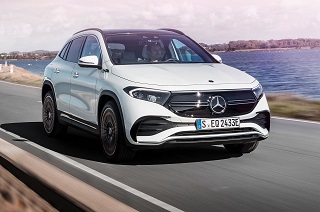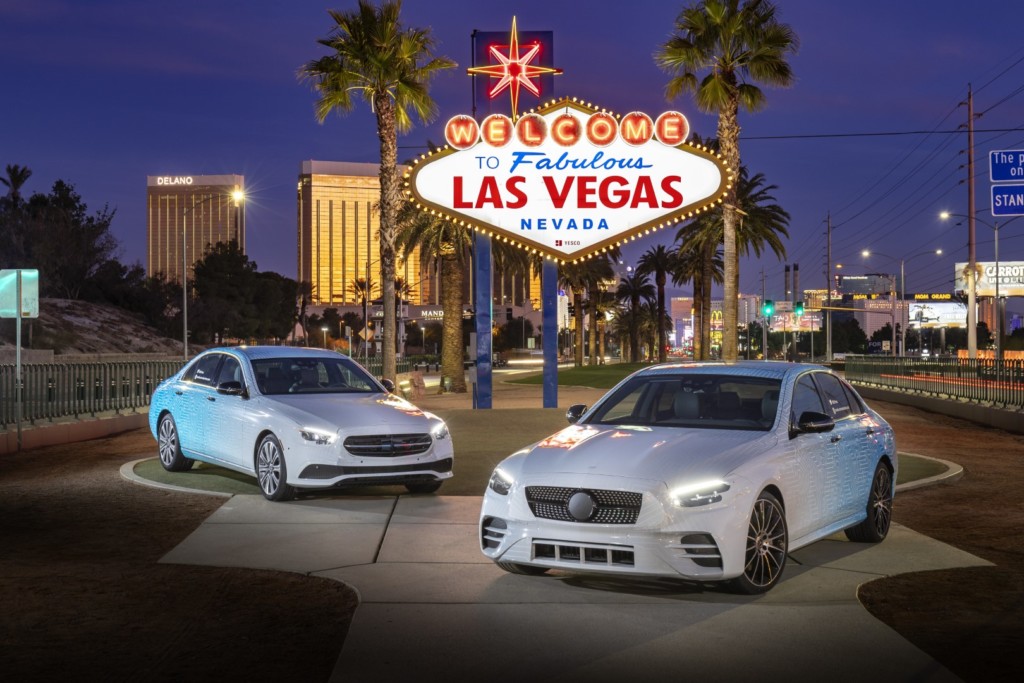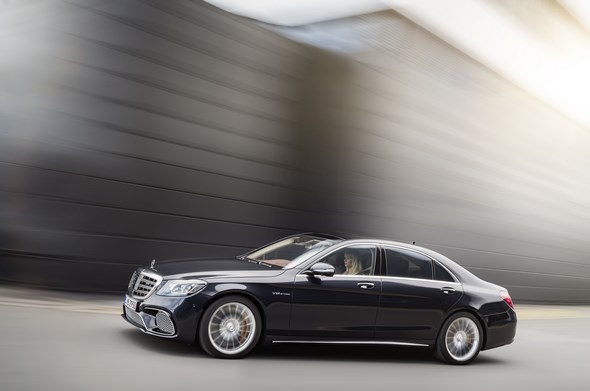Mercedes-Benz S-Classes W116-


116 series (1971 to 1980)
The first official “Mercedes-Benz S-Class” – internal designation W 116 – replaced the W 108/109 series and initially included three models, the 280 S, 280 SE and 350 SE. One noteworthy technical innovation introduced for the first time as standard in the sedans of the W 116 series was the double-wishbone front suspension with zero-offset steering and anti-dive control, which originally underwent testing in the C 111 experimental vehicle. This feature further improved handling characteristics. A new top-of-the-range model was presented in May 1975 – the 450 SEL 6.9. And from fall 1978, the S-Class sedans of the W 116 series became the first vehicles in the world equipped with a technical innovation of ground-breaking significance: The anti-lock brake system (ABS), which guaranteed the vehicle’s unrestricted steer-ing response even under emergency braking.

126 series (1979 to 1991)
In September 1979, Mercedes-Benz presented a new generation of the S-Class at the IAA in Frankfurt. The body was built according to the latest findings in safety research. Thanks to new design principles the passenger compartment could now withstand an “offset crash” at im-pact speeds up to 55 km/h. From 1981 the vehicle came with an air-bag for the driver and – following the model refinement package of 1985 – for the front passenger also.
[adsense]
Also in 1985, the engine range underwent a restructuring. The most spectacular newcomer was a 5.6-liter eight-cylinder unit which generated 200 kW (272 hp). In addition, all models in the W 126 series now came equipped with 15-inch wheels and bigger brakes to match.
During the twelve-year production period a total of 818,036 sedans left the production workshops in Sin-delfingen, making the W 126 the most successful premium-class model series in company history.

140 series (1991 to 1998)
At the Geneva Motor Show in March 1991 the company introduced the S-Class from the W 140 series. A newly developed double wishbone front axle, mounted on a subframe, provided front suspension – a sys-tem designed to isolate the body from audible and perceptible vibra-tions. Ride comfort was also improved considerably by the sound-proofing properties of the windows, the first time this feature had been used in a passenger car series.
The 6.0-liter V12 engine was a com-pletely new design, and not only the first series-produced twelve-cylinder ever built by Mercedes-Benz for a passenger car, but also the most powerful Mercedes-Benz car engine, with a rated power output of 300 kW (408 hp). In June 1993 the model designations were changed so as to place the “S” in front of the three-digit number. At the Geneva Motor Show in March 1994, the S-Class sedans appeared with discreet stylistic revisions.
With effect from December 1996 the S 280 and S 320 models with automatic transmission were also equipped with the dynamic handling control system ESP. At the same time another innovation – and world first – was put into operation: Brake Assist. At the start of its career and particularly in Germany, the largest ever S-Class did not have an easy time of it – despite having undeniable qualities. Nevertheless, by September 1998 a total of 406,532 sedans from the W 140 series had been built – 28,101 of them with diesel engines.

220 series (1998 to 2005)
With the S-Class sedan from the 220 series introduced at the Paris Motor Show in September 1998, the Mercedes-Benz product drive launched more than five years earlier reached a new high point. Over 30 new developments once again made the S-Class from Mercedes-Benz a trendsetter for passenger car design in general.
These included automatic cylinder shut-off, which converted the S 500’s eight-cylinder unit into a four-cylinder as required, DISTRONIC autonomous intelli-gent cruise control and the PRE-SAFE preventative occupant protec-tion system (introduced in 2001), with which Mercedes-Benz moved into a new era of automotive safety. Production of the W 220 series is due to come to an end in fall 2005, making way for the W 221 series. As we have come to expect from the Mercedes-Benz S-Class, this series is also sure to set new standards.

221 series (2006- )
The technical highlights of the S-Class and its predecessors
Since 1951, when the model 220 began the direct lineage of the S-Class, Mercedes-Benz has delivered around 3.3 million passenger cars from this model series to customers. This means that in terms of tradition too, this prestigious saloon easily leads the field. The S-Class has always been a trailblazer for the latest automobile technology, and as such the advance guard for the entire Mercedes-Benz brand.
A brief overview of the special technical features in the individual model series:
Model 220, W 187 series (1951 to 1954)
- Newly designed six-cylinder engine with overhead camshaft
- Patented safety conical-pin locks prevent doors from jumping open in an accident
- Fan heater available
- Duplex drum brakes at the front
Models 220 a, 220 S and 220 SE, W 180/128 series (1954 to 1959)
- Unitary body design
- Front suspension subframe
- Single-link swing axle with low centre of gravity
- Brake drums with “turbocooling”
- “Hydrak” automatic hydraulic clutch (available from 1957)
Models 220 b, 220 Sb, 220 SEb, 300 SE, W 111/112 series (1959 to 1965)
- Rigid safety passenger compartment with energy-absorbing crumple zones at the front and rear
- Steering wheel with padded boss and elimination of sharp edges in the interior
- Conical-pin door lock with two safety catches
- Disc brakes (300 SE, 220 S/SE from 1962)
- Three-point seat belts
- Four-speed automatic transmission (available from 1961)
- Air suspension (300 SE)
- Long-wheelbase version available (300 SE)
Models 250 S – 300 SE, 300 SEL – 300 SEL 6.3,
W 108/109 series (1965 to 1972)
- Safety steering system comprising telescopic steering column and steering wheel with impact absorber (from 1967)
- Hydropneumatic compensator spring at the rear axle
- Also available with eight-cylinder engine (from 1967)
S-Class 280 S to 450 SE, 280 SEL to 450 SEL 6.9, W 116 series (1972 to 1980)
- Officially known as the “S-Class” for the first time
- Fuel tank installed above the rear axle for collision protection
- Safety interior (with four-spoke safety steering wheel)
- Safety door handles
- Side windows with anti-soiling measures
- Tail lights with anti-soiling design
- Anti-lock braking system ABS (available from 1978)
- Double-wishbone front suspension from the C 111 experimental vehicle
- First luxury class saloon with a diesel engine (300 SD)
S-Class 260 SE to 560 SE, 300 SEL to 560 SEL, W 126 series (1979 to 1991)
- New safety concept, the world’s first series production car to be configured for an asymmetrical, frontal crash (offset crash)
- First use worldwide of a driver airbag and belt tensioner in a series production car (available from 1981)
- Front passenger airbag (available from 1987)
- Three-point seat belts in the rear
- Automatic locking differential
- Acceleration skid control ASR (available from 1985)
S-Class 300 SE 2.8 to S 600; 300 SEL to S 600 long-wheelbase, W 140 series (1991 to 1998)
- Electronic Stability Program ESP® (available from 1995)
- Brake Assist BAS (from 1996)
- Adaptive Damping System ADS (available from 1991)
- Seat belt system with automatic height adjustment
- Sidebags (from 1995)
- First series production Mercedes-Benz car with a twelve-cylinder engine
S-Class S 280 to S 500; S 280 long-wheelbase to S 600, W 220 series
(1998 to 2005)
- Belt tensioners and belt-force limiters in the rear
- Automatic child seat detection
- WINDOWBAG
- Occupant protection system PRE-SAFE® (from 2002)
- DISTRONIC proximity control (available from 1998)
- Automatic cylinder cut-out (S 500/S 600)
- KEYLESS-GO (available from 1998)
- AIRMATIC air suspension with adaptive damping system
- COMAND control and display system
- Active Body Control suspension
- Active seat ventilation (available from 1998)
- Bi-xenon headlamps with dynamic beam range control and headlamp cleaning system (available from 2002)
S-Class S 320 CDI to S 500; S 320 CDI long-wheelbase to S 600, W 221 series (2005-2009)
- Brake Assist PLUS with radar sensors
- DISTRONIC PLUS proximity control with extended speed range
- Parking Assist based on radar
- Dynamic multicontour seat with extended massage function
- Night View Assist with infrared technology
- Further development of PRE-SAFE® occupant protection
- World’s first automobile with an Environmental Certificate
- COMAND system with menu navigation and Controller
- “S/C/M” keys for individual adjustment of the damper and transmission characteristics and the level control system
- Blind Spot Assist (since 2006)





